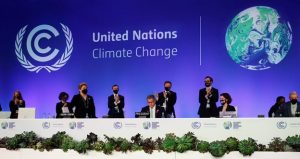Introduction
International agreements and treaties play a crucial role in the global effort to address climate change. One of the most significant agreements is the Paris Agreement, which aims to limit the global temperature rise to well below 2 degrees Celsius above pre-industrial levels, with an aspiration to limit the increase to 1.5 degrees Celsius. This ambitious target is essential for mitigating the most severe impacts of climate change, such as extreme weather events, sea-level rise, and loss of biodiversity. The Paris Agreement is a landmark accord that brings together nations from around the world to collectively work towards a sustainable and climate-resilient future.
Another pivotal treaty is the Kyoto Protocol, which sets binding emission reduction targets for developed countries. Established in 1997 and coming into force in 2005, the Kyoto Protocol was the first international treaty to impose legally binding obligations on industrialized nations to reduce their greenhouse gas emissions. This protocol laid the groundwork for subsequent climate agreements by emphasizing the need for measurable and enforceable commitments to curb emissions. The Kyoto Protocol’s mechanisms, such as the Clean Development Mechanism (CDM) and Joint Implementation (JI), have facilitated international cooperation and investment in emission reduction projects.
Role of the United Nations

The United Nations (UN) plays a vital role in coordinating global policies to combat climate change. As an international organization with a mandate to promote peace, security, and development, the UN has been instrumental in bringing countries together to address the pressing issue of climate change. Through its various bodies, such as the United Nations Framework Convention on Climate Change (UNFCCC), the UN provides a platform for negotiations, knowledge-sharing, and capacity-building among member states. The UNFCCC, established in 1992, serves as the primary international treaty for addressing climate change and has been the foundation for subsequent agreements like the Kyoto Protocol and the Paris Agreement.
In addition to its coordinating role, the UN has been actively involved in climate change mitigation and adaptation efforts. The UN’s initiatives, such as the Green Climate Fund (GCF) and the Adaptation Fund, provide financial support to developing countries to help them transition to low-carbon economies and build resilience against climate impacts. The UN also promotes sustainable development through its Sustainable Development Goals (SDGs), which include specific targets for climate action (SDG 13). By integrating climate considerations into its broader development agenda, the UN ensures that climate change remains a priority for the international community.
Impact of the Paris Agreement
The Paris Agreement has had a profound impact on global climate change mitigation policies. By fostering a sense of shared responsibility and collective action, the agreement has encouraged countries to develop and implement national climate strategies that align with the global temperature goals. The Paris Agreement’s framework of nationally determined contributions (NDCs) allows countries to set their emission reduction targets based on their unique circumstances and capabilities. This flexible approach has enabled a wide range of nations, from developed to developing, to participate in the global effort to combat climate change.
Moreover, the Paris Agreement has spurred innovation and investment in clean energy technologies and sustainable practices. By creating a predictable and transparent policy environment, the agreement has provided the necessary confidence for businesses and investors to support climate-friendly initiatives. The agreement also emphasizes the importance of transparency and accountability through its enhanced transparency framework, which requires countries to regularly report on their progress and actions. This mechanism ensures that countries remain committed to their climate goals and fosters a culture of continuous improvement and ambition.
National commitments and pledges
National commitments and pledges are essential for addressing climate change on a global scale. Each country’s commitment to reducing greenhouse gas emissions contributes to the collective effort required to meet the targets set by international agreements like the Paris Agreement. These commitments, often articulated through NDCs, reflect the unique circumstances, priorities, and capabilities of individual nations. By setting ambitious and achievable targets, countries can drive progress towards a low-carbon future and demonstrate their leadership in the fight against climate change.
Pledges made by countries play a crucial role in shaping global policies for climate change mitigation. When nations commit to specific emission reduction targets, they signal their dedication to the international community and inspire others to follow suit. These pledges also provide a basis for international cooperation and support, as countries can share best practices, technologies, and resources to achieve their climate goals. Furthermore, national commitments help to build momentum for more ambitious global actions, as countries periodically review and enhance their targets to align with the latest scientific findings and technological advancements.
Carbon pricing and trading systems

Carbon pricing is a powerful tool for mitigating climate change by reducing greenhouse gas emissions. By assigning a monetary value to carbon emissions, carbon pricing mechanisms create economic incentives for businesses and individuals to reduce their carbon footprint. There are two primary forms of carbon pricing: carbon taxes and cap-and-trade systems. Carbon taxes impose a direct fee on the carbon content of fossil fuels, encouraging energy efficiency and the adoption of cleaner energy sources. Cap-and-trade systems, on the other hand, set a limit (or cap) on total emissions and allow companies to buy and sell emission allowances within that cap.
Trading systems incentivize companies to lower their carbon footprints by providing financial rewards for reducing emissions. Under a cap-and-trade system, companies that reduce their emissions below their allocated allowances can sell their excess allowances to other companies that exceed their limits. This market-based approach promotes cost-effective emission reductions and encourages innovation in low-carbon technologies. By creating a financial incentive for emission reductions, carbon pricing and trading systems drive the transition to a low-carbon economy and support the achievement of national and international climate targets.
Monitoring and reporting mechanisms
Monitoring climate change impacts through global satellite systems is essential for understanding and responding to the evolving climate crisis. Satellite systems provide valuable data on various climate indicators, such as temperature, precipitation, sea level, and ice cover. This information is crucial for tracking the progress of climate change, assessing its impacts, and informing policy decisions. Advances in satellite technology have improved the accuracy and resolution of climate data, enabling more effective monitoring and analysis at both global and regional scales.
Climate finance and funding
Increasing climate finance is crucial for combating climate change globally. Adequate financial resources are needed to support the implementation of climate mitigation and adaptation projects, particularly in developing countries that are most vulnerable to the impacts of climate change. Climate finance can come from various sources, including public funds, private investments, and international financial institutions. Mechanisms like the Green Climate Fund (GCF) and the Global Environment Facility (GEF) play a vital role in mobilizing and distributing climate finance to support sustainable development and resilience-building efforts.
Allocating funding for climate change mitigation and adaptation efforts is essential for achieving global climate goals. Financial support can help countries transition to low-carbon economies, develop adaptive infrastructure, and implement sustainable practices in sectors like agriculture, forestry, and water management. By prioritizing climate finance, the international community can ensure that all countries have the resources needed to address the multifaceted challenges of climate change and build a more sustainable and equitable future.
Renewable energy policies

Renewable energy policies are critical for mitigating the effects of climate change. By promoting the development and deployment of renewable energy sources, such as solar, wind, hydro, and geothermal, these policies help to reduce reliance on fossil fuels and decrease greenhouse gas emissions. Renewable energy policies can take various forms, including feed-in tariffs, renewable portfolio standards, tax incentives, and subsidies for research and development. These measures create a favorable environment for investment in renewable energy projects and support the growth of clean energy industries.
Global policies are essential for addressing the challenges posed by climate change. Coordinated efforts at the international level can accelerate the transition to renewable energy and ensure that all countries have access to the technologies and resources needed to achieve their climate goals. International cooperation can also facilitate the sharing of best practices and the development of standardized frameworks for measuring and reporting renewable energy progress. By working together, countries can overcome barriers to renewable energy adoption and build a sustainable and resilient global energy system.
Adaptation and resilience strategies
Developing adaptive infrastructure is key to building resilience against the impacts of climate change. As climate change intensifies, communities around the world are experiencing more frequent and severe weather events, such as hurricanes, floods, and droughts. Adaptive infrastructure, such as resilient buildings, flood defenses, and early warning systems, can help communities withstand these impacts and recover more quickly. Investing in adaptive infrastructure not only protects lives and livelihoods but also reduces the economic costs associated with climate-related disasters.
Implementing sustainable agricultural practices is another important strategy for addressing the impacts of climate change. Climate change poses significant risks to food security, as changing weather patterns and extreme events can disrupt agricultural production. Sustainable practices, such as conservation agriculture, agroforestry, and integrated pest management, can enhance the resilience of agricultural systems and ensure a stable food supply. By promoting sustainable agriculture, countries can protect their food security and support the livelihoods of farmers and rural communities.
Conclusion
Reporting climate change data to international regulatory bodies is a key component of global climate governance. Transparent and consistent reporting allows countries to demonstrate their progress towards climate goals, share their experiences, and hold each other accountable. International regulatory bodies, such as the UNFCCC, use this data to assess the effectiveness of climate policies and identify areas where additional support or action is needed. By maintaining robust monitoring and reporting mechanisms, the international community can ensure that climate actions are based on sound science and that progress towards global climate goals is continuously evaluated and enhanced.




